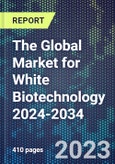White biotechnology harnesses living cells collected from yeast, molds, microorganisms and plants, and enzymes to produce renewable fuels, chemicals, materials and medicines. It relies on principles of biotechnology, molecular biology and synthetic biology to engineer organisms that efficiently convert raw materials into value-added products, that can be easily degraded, consume less energy and create less waste.
Key tools like metabolic engineering, fermentation, enzymatic biocatalysis, and directed evolution allow the biology of bacteria, yeast and algae to be optimized as microbial cell factories. Their metabolism can be tailored to convert sugars, waste lipids and even CO2 into target compounds like ethanol, organic acids, biopolymers and more. White biotechnology enables the sustainable production of both high-volume commodities as well as fine chemicals for pharmaceuticals. It allows renewable feedstocks like agricultural wastes and algae to be utilized as inputs. Biomanufacturing processes can achieve high specificity under mild conditions with far less waste than conventional chemistry.
Report contents include:
- Principles and tools of white biotechnology. Analysis of major host organisms - engineered bacteria, yeast, algae, fungi - used in industrial biotechnology.
- Key end product applications and markets. Markets covered include biofuels, renewable chemicals, bioplastics, ingredients, agriculture, cosmetics, textiles, and more. Analysis of market drivers, challenges, regulations, and outlook.
- Insights into biomanufacturing processes and scale-up for commercialization. Batch vs continuous processing, bioreactors, downstream separation, and process analytical techniques.
- Techno-economic analysis and market outlook.
- Latest trends and future opportunities.
- Global market revenues to 2034.
- 182 company profiles spanning feedstock supply, biomanufacturing, and end-product companies. Analysis of how startups, SMEs, and large corporations apply biotech across the value chain.
- Companies profiled include ÄIO, Ardra Bio, Bolt Threads, Cascade Biocatalysts, C16 Biosciences, Circe, Danimer Scientific, Debut Biotechnology, Fermelanta, Future Fields, Gingko Bioworks, Green Bioactives, HydGene Renewables, LanzaTech, Metabolic Explorer, Michroma, Modern Meadow, Newlight Technologies, Novozymes, Onego Bio, Pearl Bio, Pivot Bio, Provectus Algae, Seminal Biosciences, Spiber, Succinity, Terra Bioindustries, Visolis, and Yali Bio.
This product will be delivered within 1-3 business days.
Table of Contents
1 RESEARCH METHODOLOGY
Companies Mentioned (Partial List)
A selection of companies mentioned in this report includes, but is not limited to:
- Aemetis, Inc.
- AgBiome
- Agronomics
- ÄIO
- Algal Bio Co., Ltd.
- Algenol
- AlgiKnit
- Alpha Biofuels (Singapore) Pte Ltd
- AMSilk GmbH
- Antheia
- Arctic Biomaterials Oy
- Ardra Bio
- Arzeda
- Asimov
- AVA Biochem AG
- Avantium B.V.
- Azolla
- BASF
- BBCA Biochemical & GALACTIC Lactic Acid Co., Ltd.
- Benefuel Inc.
- Bio Fab NZ
- Bioextrax AB
- Biokemik
- BIOLO
- Biomason, Inc.
- Bioplastech Ltd
- Biosynthia
- Biotic Circular Technologies Ltd.
- Bioweg
- bit.bio
- Bloom Biorenewables SA
- BluCon Biotech GmbH
- Blue BioFuels, Inc.
- Bluepha Beijing Lanjing Microbiology Technology Co., Ltd.
- Bolt Threads
- Bosk Bioproducts Inc.
- Bowil Biotech Sp. z o.o.
- Braskem SA
- Bucha Bio, Inc.
- C1 Green Chemicals AG
- C16 Biosciences
- CABIO Biotech (Wuhan) Co, Ltd
- Calysta
- Calyxt
- Camena Bioscience
- Carbios
- Cascade Biocatalysts
- Catalyxx
- Cauldron
- Chitose Bio Evolution Pte Ltd.
- CinderBio
- Circe
- CJ Biomaterials, Inc.
- Clean Food Group
- Colossal Biosciences
- Conagen
- Constructive Bio
- Danimer Scientific
- Debut Biotechnology
- Deep Branch Biotechnology
- Demetrix
- Domsjö Fabriker AB
- DSM
- DuPont
- Eco Fuel Technology, Inc
- Ecovative
- EggPlant Srl
- Elo Life Systems
- Emerging Fuels Technology (EFT)
- EnginZyme
- ENOUGH
- Enzymit
- Epoch Biodesign
- Evolved By Nature
- Farmless
- Fermelanta
- Full Cycle Bioplastics LLC
- Futerro
- Future Fields
- Gaiamer Biotechnologies
- Geltor
- Gen3Bio
- Genecis Bioindustries, Inc.
- Genomatica
- Gevo, Inc
- Ginkgo Bioworks
- Green Bioactives
- Green Earth Institute
- Hyfé
- Insempra
- Kalion, Inc.
- Kinish
- Kraig Biocraft Laboratories
- Lanzatech
- LCY Biosciences
- Loam Bio
- LXP Group GmbH
- Lygos, Inc
- MakeGrowLab
- Mango Materials, Inc.
- Marea
- MedPHA Bio-Tech Co., Ltd
- Melt & Marble
- METabolic EXplorer S.A. (METEX)
- Metgen Oy
- Michroma
- Modern Meadow
- Modern Synthesis
- Molecular Assemblies
- Multus Biotechnology
- Myconeos
- MycoTechnology
- MycoWorks
- Nafigate Corporation a.s.
- NatPol
- Nature's Fynd
- NatureWorks LLC
- NefFa
- Nereid Biomaterials
- Newlight Technologies LLC
- Ningbo Tianan Biologic Material
- NoPalm Ingredients
- Notpla
- Nourish
- Novomer
- Novozymes A/S
- Oakbio, Inc.
- Octarine Bio
- Oimo
- Onego Bio
- Paques Biomaterials
- Pearl Bio
- Perfect Day
- PHABuilder
- Photanol B.V.
- Pili
- Pivot Bio
- Plastus
- Polybion
- Polyferm
- Praj Industries Ltd.
- Prometheus Materials
- Protein Evolution
- Provectus Algae
- Roquette S.A.
- RWDC
- Samsara Eco Pty Ltd.
- Saphium Biotechnology GMBH
- Scindo
- Seevix Material Sciences Ltd.
- Sekab E-Technology AB
- Seminal Biosciences
- Smartfiber AG
- Solar Foods
- Solugen
- Soma Bioworks/White Lemur Co.
- Spiber, Inc.
- Spidey Tek
- Spinnova
- St1 Oy
- Succinity
- SUPLA Bioplastics
- SWAY
- Teal Bioworks, Inc.
- Terra BIoindustries Inc.
- Teysha Technologies Limited
- thyssenkrupp Industrial Solutions AG
- Tianjin GreenBio Materials Co., Ltd
- Total Corbion
- Treemera GmbH
- TripleW
- Uluu
- VEnvirotech Biotechnology SL
- Versalis SpA
- Vertus Energy Ltd.
- Virent Inc.
- Visolis
- Wild Microbes
- Yali Bio
- Yield10 Bioscience, Inc.
- Zero Acre
- Zymergen
Methodology

LOADING...







